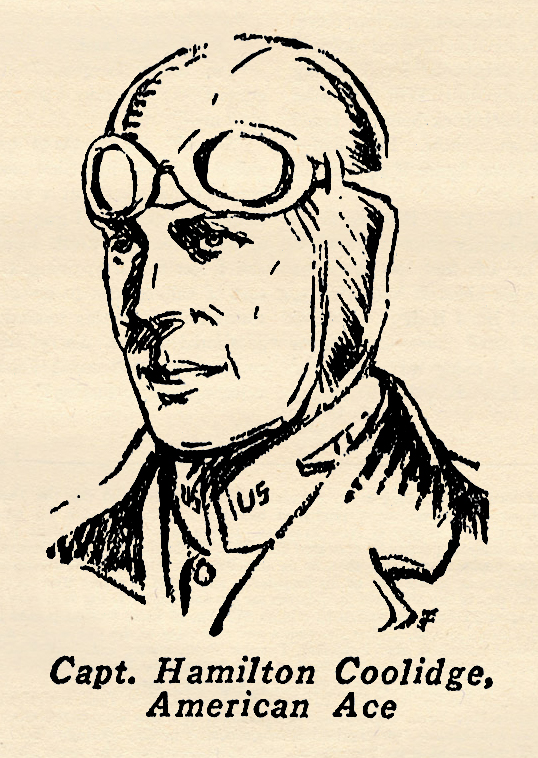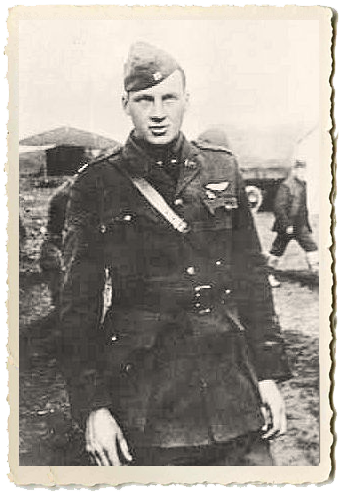Amidst all the great pulp thrills and features in Sky Fighters, they ran a true story feature collected by Ace Williams wherein famous War Aces would tell actual true accounts of thrilling moments in their fighting lives! This time we have American Flyer Captain Hamilton Coolidge’s most thrilling sky fight!
As a famous athlete at Harvard,  Hamilton Coolidge was well known throughout the land even before the war began. He enlisted in the aviation section of the Signal Corps and got his primary flight training at Mineola along with Quentln Roosevelt, his hoy-hood friend.
Hamilton Coolidge was well known throughout the land even before the war began. He enlisted in the aviation section of the Signal Corps and got his primary flight training at Mineola along with Quentln Roosevelt, his hoy-hood friend.
They went up to the front together on the same day. Coolidge was assigned to the 94th Squadron and Roosevelt to the 95th. Coolidge was killed when a German Archie scored a direct hit on his plane, something of which war time figures prove happened only once in every 20,000 attempts.
He had established an enviable record, soon becoming a recognized ace with 5 victories. He was promoted to a Squadron Commander, and succeeded in downing 3 more enemy planes. He was awarded both the Croix de Guerre and the Distinguished Service Cross. This account of his fight with the famous Flying Circus of Baron von Richthofen is taken from an interview he gave a war correspondent.
FIGHTING THE FLYING CIRCUS
by Captain Hamilton Coolidge • Sky Fighters, October 1935
THOUGH I had been expecting to encounter the Flying Circus, my first meeting with one of their patrols took me quite by surprise. With five of my mates I was cruising high above Lagny in a sky that was empty and void as a lonesome ocean.
I didn’t catch sight of the gaudily painted ships until they were almost upon us— they had come up from our own side of the lines, while I was probing the sky reaches in the opposite direction. Twelve ships there were, flying in layer formation.
I had to do some quick thinking. My patrol was outnumbered 2 to 1. And they had us cut off from our rear! I waggled my wings, whined up in vertical virage and went streaking for Germany, climbing for the ceiling as I ran.
We Gained an Even Ceiling
Luckily, the Fokkers didn’t catch us until we had gained an even ceiling with their topmost flight. Then the fighting began. It seemed that the bullets whined in from all directions at once. And the sky was just a kaleidoscopic whirl.
Finally the wild dog-fighting settled down to a man to man duel. I didn’t have to pick my quarry. He picked me with a ripping invitation in Spandau tracer that stitched a grim streak down my turtle-back. I jammed full throttle and roared into a loop, rolled out on top and got out of range. But only to run smack into a stream of tracer coming from another Hun’s gun. I ducked beneath that, pulled up and banked quickly, my sights on the checkerboard belly of my first antagonist. I had time for just a short burst before he slid out of my sights.
First Meat for Our Side
But that was enough. The Fokker tipped up on a wing, hung in the air momentarily, then went sliding down, turning over on its back finally and fluttering off in a spin.
It was first meat for our side against odds of two to one. It gave me renewed courage. Two more of the Fokkers fell before one of the Spad pilots got caught with a bad jam. While trying to clear it he was killed.
All the time we had been fighting we had drifted further over the German lines, so I concluded that now was the time for a risky maneuver. We would have to turn our tails to the Huns, give them a momentary bull’s-eye as we streaked for the earth straight down—but with the Spad’s diving speed with full power on, I figured we could leave the Fokkers behind, and take our chances with the Archies and groundfire from below. So I signalled and dived, the rest of the boys following.
I took plenty of lead in the rear, but by shaking my stick, I managed to dodge a vital burst, and finally got out of range.
We hedge-hopped for home then right over the German trenches, running the gauntlet of a terrific machine-gun fire from the ground. But when we had run through and zoomed up to the ceiling and reformed on our own side of the line, waiting, the famed Flying Circus didn’t accept the challenge.







 Hamilton Coolidge was well known throughout the land even before the war began. He enlisted in the aviation section of the Signal Corps and got his primary flight training at Mineola along with Quentln Roosevelt, his hoy-hood friend.
Hamilton Coolidge was well known throughout the land even before the war began. He enlisted in the aviation section of the Signal Corps and got his primary flight training at Mineola along with Quentln Roosevelt, his hoy-hood friend. was born on September 1st, 1895, in Brookline, Massachusetts. He enlisted in the Aviation Section of the U.S. Army Signal Corps in July 1916, and began flight training at the School of Military Aeronautics at the Massachusetts Institute of Technology in June the following year.
was born on September 1st, 1895, in Brookline, Massachusetts. He enlisted in the Aviation Section of the U.S. Army Signal Corps in July 1916, and began flight training at the School of Military Aeronautics at the Massachusetts Institute of Technology in June the following year.